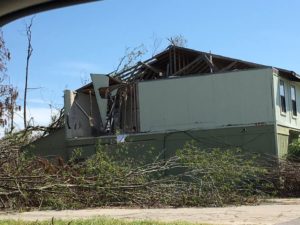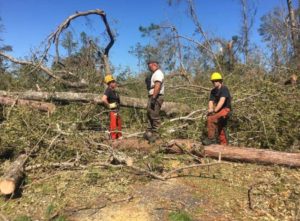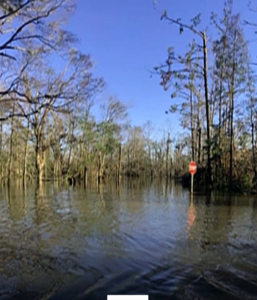New wildfire threat posed by storm debris

An unrepaired Panama City home damaged from Hurricane Michael, March 10, 2019
In the five months since Hurricane Michael struck the Panhandle, Florida has received almost $1 billion in federal disaster assistance in the form of grants, loans, and federal flood insurance payments. But in the meantime a new menace is brewing, with state fire officials warning that we’re facing an imminent wildfire threat from tree debris as we head into the usually drier and windier spring season.
So far, the state has received $957 million in federal disaster help. It includes assistance for individuals who were uninsured or underinsured, to help them repair their homes, find a temporary place to live, and pay for related living needs; SBA loans businesses and individuals, and $195 million in flood claims paid to more than 4,000 policyholders of the National Flood Insurance Program (NFIP). The full breakout of federal funding is provided here from FEMA.
Apart from the Individual Assistance program, another $5.6 million in grants from FEMA’s Public Assistance program have gone to hard-hit communities recovering from Hurricane Michael. It covers the costs for emergency measures to protect lives or property, debris cleanup and removal, and the repair and replacement of disaster-damaged infrastructure. That figure is expected to grow as bills are tallied, with the feds picking up 100% of the cost for the first 45 days after the October 10 storm and 75% afterward for qualified expenses.

Work crews continue to clear away trees from Three Rivers State Park in Sneads, FL. Courtesy, Fla DEP
The big expense for now is debris removal. To date, 29 million cubic yards of disaster debris have been removed, which is a vital step in hurricane recovery. But much more remains, as the storm created an estimated 72 million cubic yards – 10 times the amount from Hurricane Irma.
The head of the state forest service warned last week that Michael has left behind a growing wildfire threat. State Forester Jim Karels appeared before the Governor and Cabinet warning that the fire threat is greater than that of California, which just saw major wildfires. “If we have three weeks without rain and a windy day, we’re ready to go,” Karels said. The only way to fight such a fire would be by using much more expensive aircraft he said, as many roads in forests are still impassable.

A flooded road inside Florida Caverns State Park in Marianna, FL. Courtesy, Fla DEP
The downed trees are also clogging smaller waterways lots more than they did in Hurricanes Irma and Matthew, which is causing flooding problems for Panhandle roadways and structures. Contractors are working to remove debris from water with specially equipped boats. Deputy DEP Director Barbara Goodman told the Governor and Cabinet that she expects to spend $167 million just on waterway debris removal, compared to the $65 million spent for the same in Irma and Matthew combined. Some state parks have 80% of their trees damaged. Florida legislators are considering a variety of proposals to fund debris cleanup (more in this edition’s Bill Watch).
The legislature is also being urged to look at revising building codes for the Panhandle, which require homes be built to withstand winds of 120 mph. As we’ve shown before here in the LMA Newsletter and discussed with adjusters and contractors on our Florida Insurance Roundup podcast those homes that survived the direct path of Michael’s 155 mph winds were those built to the tougher South Florida building standards. It’s a point that Bill Newton of the Florida Consumer Action Network recently made in this opinion column he wrote for the Tallahassee Democrat. Resiliency needs to be a priority going forward.
LMA Newsletter of 3-18-19

